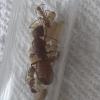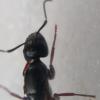Yesterday I saw a C. pennsylvanicus male alate in a bush, plus that one that got snatched by the Vespula.
- Formiculture.com
- Forums
- Gallery
- Members
- Member Map
- Chat

Yesterday I saw a C. pennsylvanicus male alate in a bush, plus that one that got snatched by the Vespula.
Due to a supreme lack of test tubes, I stuffed four C. chromaiodes queens in the same tube. They are actually getting along great! I saw them feeding and grooming each other today.
What!?!? aren't they monogyne?
Lesson for today: Always be prepared.
Was out cleaning up some scrap wood from a weekend project and disturbed a Camponotus americanus queen. But alas, I had nothing to container her with. So I put everything back the exact way she had it and ran to find something. I even waited a few seconds to see if I'd see her fleeing.
Come back, and nothing. She was gone.
Also, found a colony I didn't know about in my yard. They were trying to relocate to my mailbox, brood and all. Having fun trying to identify them, they're so tiny -- I'm leaning towards L. Niger . The workers are 2-3mm, no visible petiole node, but - no sign of hair even at 40x magnification.
And - I put some christmas gift cards to good use. My copy of A Field Guide to New England Ants will arrive Thursday.
Founding:
1 P. Imparis queen caught 4/26/18
2 L. Umbratus caught 5/8/18
1 C. Pennsylvanicus queen caught 5/7/18 1st Eggs 5/17/18
1 C. Pennsylvanicus queen caught 5/17/18 1st Eggs 5/22/18
1 C. Pennsylvanicus queen caught 5/31/18
1 T. Caespitum(?) queen caught 6/1/18
@mallonje Yeah, we've all been there before ![]() I missed out today on some sort of queen I didn't recognize walking out the door today too. I opened the door, looked down and there she was. I totally forgot I had a test tube in my pocket as was concerned about getting run over/hit by the door, so I let her go. Was kicking myself on the way home as had no idea what she was, and realized after I had the test tube, and could have used my ID card to move her in. I also did it on Sun when I was clearing leaves out; that's when I found a pair of C. nearcticus alates running around. I had no test tubes, so grabbed in the glove carefully until I could inside to grab one. Once it's June, I pretty much always have a test tube on me wherever I go. My coworkers tease me but I don't care, especially as never know when you might find something.
I missed out today on some sort of queen I didn't recognize walking out the door today too. I opened the door, looked down and there she was. I totally forgot I had a test tube in my pocket as was concerned about getting run over/hit by the door, so I let her go. Was kicking myself on the way home as had no idea what she was, and realized after I had the test tube, and could have used my ID card to move her in. I also did it on Sun when I was clearing leaves out; that's when I found a pair of C. nearcticus alates running around. I had no test tubes, so grabbed in the glove carefully until I could inside to grab one. Once it's June, I pretty much always have a test tube on me wherever I go. My coworkers tease me but I don't care, especially as never know when you might find something.
L. niger aren't really common in the US, HOWEVER, I bet it was Lasius alienus. I find sometimes they will relocate like that (and I don't know why.) Interesting fact; L. alienus fly around the same time as L. niger does in the summer, much earlier than most of the other Lasius native to the US. There's been theories that they may be closely related to L. niger. I have noticed L. alienus queens are noticeably smaller than other Lasius queens as well. They also are one of the few Lasius that lay before hibernation, often with the first workers before.
Congrats on the book, I bet you like it. I keep it bed side, and often before bed when trying not to over do screen time, will pick it up and thumb through it. It has some flow charts for ID'ing ants which is really handy. It really opened me eyes to how many ants are here.
I'm starting to hit overload on colonies, think I may need to start thinning out soon. As much as I like my Lasius, I have SO many.
BTW Fri and Sat are supposed to be hot in the upper 80Fs, worth keeping an eye on for flights.
Not to get cocky but - 2 for 2 on C. Pennsylvanicus. My second C. P. queen has laid eggs already.
Founding:
1 P. Imparis queen caught 4/26/18
2 L. Umbratus caught 5/8/18
1 C. Pennsylvanicus queen caught 5/7/18 1st Eggs 5/17/18
1 C. Pennsylvanicus queen caught 5/17/18 1st Eggs 5/22/18
1 C. Pennsylvanicus queen caught 5/31/18
1 T. Caespitum(?) queen caught 6/1/18
@jemallone That's great, congrats! I also saw your post on L. umbratus, good luck ![]() I've twice now succeeded with my L. alienus where I lost the queen during hibernation and introduced an L. umbratus, however with only a couple workers, I've never gotten to the point of her laying.
I've twice now succeeded with my L. alienus where I lost the queen during hibernation and introduced an L. umbratus, however with only a couple workers, I've never gotten to the point of her laying.
My C. noveboracensis queen didn't make it, sorry @Myrmidon ![]() However I'll watch out for more and collect them for you. On the plus side, all four of my C. americanus have laid, so may have one of those for you as well if they all make it.
However I'll watch out for more and collect them for you. On the plus side, all four of my C. americanus have laid, so may have one of those for you as well if they all make it.
Today is supposed to hit 80Fs, so may be worth watching out for flights.
Just another friendly reminder to watch out for ticks, this is a very bad year for them. We're really religious about looking for them, yet still found a deer tick in my belly button last night #HeebieJeebies. Finding them on our indoor cats too which hasn't happened before, so this year is a bad year, so definitely be mindful!
Aww bummer! It's alright. I know how that goes. I'm still shocked my Formica sp. colony is still carrying on considering all my newbie mistakes I made last year. Lots of my founding queens didn't make it but it's a learning process.
But thank you for watching out for new ones! And yes, do keep me in mind for any "spares". I'm going to be watching tonight for flights - perhaps the C. pennsylvanicus and C. chromaoides in my area will fly so I can give you good news! I may even make a trip to Walden Pond Park and do some hunting during the day today so I'll bring some tubes along with me.
Keeper of:
Prenolepis imparis (4 founding queens)
Camponotus pennsylvanicus (5 founding queens)
Reticulitermes flavipes (3 pairs, subterranean termite)
Any advice for looking for ants in urban areas? I live in Boston and there are very few places for me to go, and I'm not really seasoned enough to know exactly where to look for any kind of ants we have up here
Welcome to the group @Luvnecrosis! I'm outside the city, so don't have a lot of experience inside the city. However I know from chatting with people that P. imparis, Nylandria sp., Tetramorium and occasionally Camponotus and Lasius are found in the city.
I just noticed there's a GAN person in NH now, I got all excited for some of the NH people until I saw C. pennsylvanicus queen + 2 workers =$95. Oh my. They fly by the hundreds here on their big flight, I could pay off my mortgage with these rates ![]()
Welcome!
I'm new too, and if it makes you feel better - of the 6 queens I caught this year only two were caught on dirt, one of those it was dirt next to a sidewalk and the other was on the mulch under a tree in a parking lot.
If you think about it, Ants will be ants regardless of whether they're in the city or not. So on warm days like today - look for flights. Keep your eyes open for stray ants. When the weather is nice I look each morning and each evening. On occasion I go out at lunch. You may not see the nests emptying, or the cloud of ants flying, it could just be a dealate looking for cool place to dig in and nest.
I'm currently operating under the hypothesis that on really hot days - black top gets too hot for them. I've found 3 queens on white concrete sidewalks and another in the shade on a brick wall, after having walked across hot black top. Again this is just my hypothesis, but is seems to play out. Ants seem to scurry quick across black top but will take their time on concrete.
Edited by mallonje, May 23 2018 - 9:44 AM.
Founding:
1 P. Imparis queen caught 4/26/18
2 L. Umbratus caught 5/8/18
1 C. Pennsylvanicus queen caught 5/7/18 1st Eggs 5/17/18
1 C. Pennsylvanicus queen caught 5/17/18 1st Eggs 5/22/18
1 C. Pennsylvanicus queen caught 5/31/18
1 T. Caespitum(?) queen caught 6/1/18
I'm currently operating under the hypothesis that on really hot days - black top gets too hot for them. I've found 3 queens on white concrete sidewalks and another in the shade on a brick wall, after having walked across hot black top. Again this is just my hypothesis, but is seems to play out. Ants seem to scurry quick across black top but will take their time on concrete.
Probably not far from the truth at all. Many species move their colonies up/down within nests to regulate temperature. In the Spring, many species will move brood close to the surface, especially under a rock to warm them up (this time of year you'll see lots of Tetramorium and Lasius colonies very close to the surface beneath rocks). Aphaenogaster is known relocate entire nest locations based on season as well to regulate their temperatures. P. imparis dig very very deep nest, so during the heat of the summer, they can be several meters down where it's cooler and more stable. So they do take temperature into consideration for what they do.
drtrmiller somewhere had posted here an interesting idea that maybe the queens fly at the optimal conditions for the brood, which is why many fly on hot/humid days.
LIke mallonje, anytime it's nice like this, I have a test tube in my pocket if I go outside, as invariably whenever I don't have one, I miss something. 80F degree days and humid, often following rains is a great time to look. This time of year is *just* getting started for the flights, so it's only going to get better. Being there's a lot of urban species, I bet if you go out during the right conditions, especially near Boston Common or other large parks, I'd be surprised if you didn't find something. As mallonje mentioned, in more urban areas around work, I've often found queens on the side walk areas, which makes them easier to spot. It's not quite as easy as the older Ant Canada videos where he walks outside, and then looks like minutes later finds a queen on the side walk... However if the conditions are right, it's a bit closer to reality.
Founding:
1 P. Imparis queen caught 4/26/18
2 L. Umbratus caught 5/8/18
1 C. Pennsylvanicus queen caught 5/7/18 1st Eggs 5/17/18
1 C. Pennsylvanicus queen caught 5/17/18 1st Eggs 5/22/18
1 C. Pennsylvanicus queen caught 5/31/18
1 T. Caespitum(?) queen caught 6/1/18
Most be a south-easterly flight so far, someone in Taunton, MA also reporting they are flying now as well.
Didn't end up going to Walden but definitely going to be camping out in the yard with some wine and my blacklights this eve. ![]()
Keeper of:
Prenolepis imparis (4 founding queens)
Camponotus pennsylvanicus (5 founding queens)
Reticulitermes flavipes (3 pairs, subterranean termite)
Founding:
1 P. Imparis queen caught 4/26/18
2 L. Umbratus caught 5/8/18
1 C. Pennsylvanicus queen caught 5/7/18 1st Eggs 5/17/18
1 C. Pennsylvanicus queen caught 5/17/18 1st Eggs 5/22/18
1 C. Pennsylvanicus queen caught 5/31/18
1 T. Caespitum(?) queen caught 6/1/18
Been thinking/ researching about blacklighting.
Have you done it before? Any luck with it?
I've always have success with them when the conditions are prime for nuptials. I found that throwing a white (thin) sheet over a mosquito trap light works as well and then I just collect the queens caught on the sheet which often minimizes damage because they roll right into my tubes. It also saves me the aimless wandering in the woods at night because they just seem to be attracted to the light source itself. Which is funny since they want nothing but total darkness afterwards. ![]()
Keeper of:
Prenolepis imparis (4 founding queens)
Camponotus pennsylvanicus (5 founding queens)
Reticulitermes flavipes (3 pairs, subterranean termite)
I've always have success with them when the conditions are prime for nuptials. I found that throwing a white (thin) sheet over a mosquito trap light works as well and then I just collect the queens caught on the sheet which often minimizes damage because they roll right into my tubes. It also saves me the aimless wandering in the woods at night because they just seem to be attracted to the light source itself. Which is funny since they want nothing but total darkness afterwards.
I really like that idea, that's a good one! I got one of the DJ lights in the 365nm range, but haven't had a chance yet to try it this year. Putting a thin sheet over it is a brilliant idea!
We just had a shower go thru, still in the mid-70s and humidity creeping up. Still not too late for a flight, though Fri/Sat looking better and better.
Founding:
1 P. Imparis queen caught 4/26/18
2 L. Umbratus caught 5/8/18
1 C. Pennsylvanicus queen caught 5/7/18 1st Eggs 5/17/18
1 C. Pennsylvanicus queen caught 5/17/18 1st Eggs 5/22/18
1 C. Pennsylvanicus queen caught 5/31/18
1 T. Caespitum(?) queen caught 6/1/18
Ants & Myrmecology →
General →
Want to connect with other ant keepers in MaineStarted by Naturenut1233 , Mar 29 2024 |
|

|
||
Market Place →
General Market Place →
Ottercl's Ant Shop (Massachusetts)Started by Ottercl , Aug 4 2023 |
|

|
||
Anting →
Ant ID Requests →
Can anyone identify which ant this is?Started by KodexFB , Sep 26 2022 |
|

|
||
Ant Keeping →
General Ant Keeping →
Can anyone identify which ant this is?Started by KodexFB , Sep 26 2022 |
|

|
||
Market Place →
General Market Place →
Looking to buy Queens/Already built colony's in CTStarted by OliverO , Nov 11 2021 |
|

|
0 members, 0 guests, 0 anonymous users